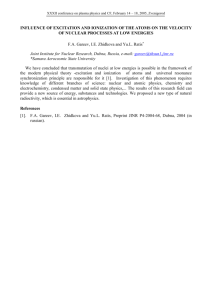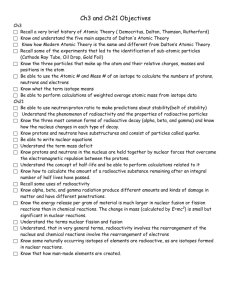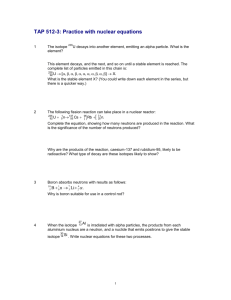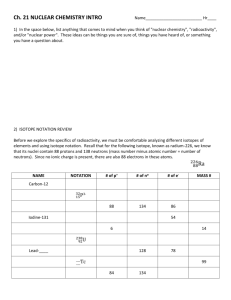Eng - JINR FLNR
advertisement
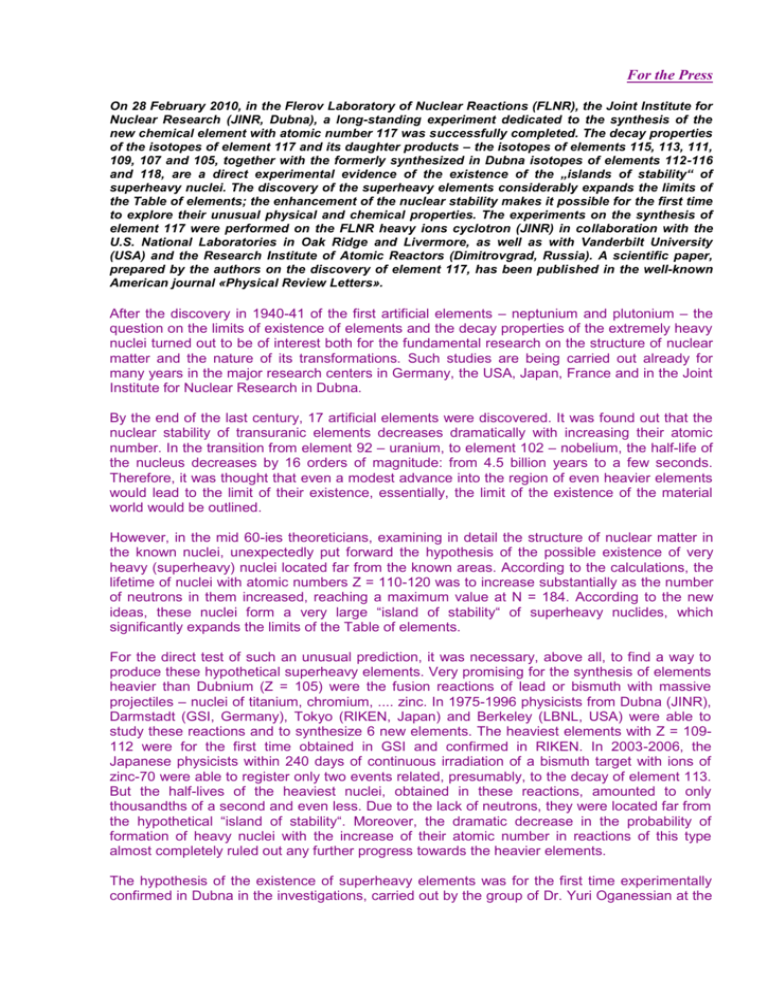
For the Press On 28 February 2010, in the Flerov Laboratory of Nuclear Reactions (FLNR), the Joint Institute for Nuclear Research (JINR, Dubna), a long-standing experiment dedicated to the synthesis of the new chemical element with atomic number 117 was successfully completed. The decay properties of the isotopes of element 117 and its daughter products – the isotopes of elements 115, 113, 111, 109, 107 and 105, together with the formerly synthesized in Dubna isotopes of elements 112-116 and 118, are a direct experimental evidence of the existence of the „islands of stability“ of superheavy nuclei. The discovery of the superheavy elements considerably expands the limits of the Table of elements; the enhancement of the nuclear stability makes it possible for the first time to explore their unusual physical and chemical properties. The experiments on the synthesis of element 117 were performed on the FLNR heavy ions cyclotron (JINR) in collaboration with the U.S. National Laboratories in Oak Ridge and Livermore, as well as with Vanderbilt University (USA) and the Research Institute of Atomic Reactors (Dimitrovgrad, Russia). A scientific paper, prepared by the authors on the discovery of element 117, has been published in the well-known American journal «Physical Review Letters». After the discovery in 1940-41 of the first artificial elements – neptunium and plutonium – the question on the limits of existence of elements and the decay properties of the extremely heavy nuclei turned out to be of interest both for the fundamental research on the structure of nuclear matter and the nature of its transformations. Such studies are being carried out already for many years in the major research centers in Germany, the USA, Japan, France and in the Joint Institute for Nuclear Research in Dubna. By the end of the last century, 17 artificial elements were discovered. It was found out that the nuclear stability of transuranic elements decreases dramatically with increasing their atomic number. In the transition from element 92 – uranium, to element 102 – nobelium, the half-life of the nucleus decreases by 16 orders of magnitude: from 4.5 billion years to a few seconds. Therefore, it was thought that even a modest advance into the region of even heavier elements would lead to the limit of their existence, essentially, the limit of the existence of the material world would be outlined. However, in the mid 60-ies theoreticians, examining in detail the structure of nuclear matter in the known nuclei, unexpectedly put forward the hypothesis of the possible existence of very heavy (superheavy) nuclei located far from the known areas. According to the calculations, the lifetime of nuclei with atomic numbers Z = 110-120 was to increase substantially as the number of neutrons in them increased, reaching a maximum value at N = 184. According to the new ideas, these nuclei form a very large “island of stability“ of superheavy nuclides, which significantly expands the limits of the Table of elements. For the direct test of such an unusual prediction, it was necessary, above all, to find a way to produce these hypothetical superheavy elements. Very promising for the synthesis of elements heavier than Dubnium (Z = 105) were the fusion reactions of lead or bismuth with massive projectiles – nuclei of titanium, chromium, .... zinc. In 1975-1996 physicists from Dubna (JINR), Darmstadt (GSI, Germany), Tokyo (RIKEN, Japan) and Berkeley (LBNL, USA) were able to study these reactions and to synthesize 6 new elements. The heaviest elements with Z = 109112 were for the first time obtained in GSI and confirmed in RIKEN. In 2003-2006, the Japanese physicists within 240 days of continuous irradiation of a bismuth target with ions of zinc-70 were able to register only two events related, presumably, to the decay of element 113. But the half-lives of the heaviest nuclei, obtained in these reactions, amounted to only thousandths of a second and even less. Due to the lack of neutrons, they were located far from the hypothetical “island of stability“. Moreover, the dramatic decrease in the probability of formation of heavy nuclei with the increase of their atomic number in reactions of this type almost completely ruled out any further progress towards the heavier elements. The hypothesis of the existence of superheavy elements was for the first time experimentally confirmed in Dubna in the investigations, carried out by the group of Dr. Yuri Oganessian at the Flerov Laboratory of Nuclear Reactions (FLNR), in the Joint Institute for Nuclear Research (JINR), in collaboration with scientists from the Lawrence Livermore National Laboratory (USA). Yu.Ts. Oganessian and his colleagues radically changed the approach to the synthesis of superheavy nuclei. Instead of lead and bismuth they used as target material isotopes of transuranic elements with a large excess of neutrons. The extremely rare and very expensive isotope of element 20 – calcium – with mass number 48 was chosen as the projectile; relative to the most abundant isotope of the element (calcium-40), this nucleus has 8 extra neutrons. At the heavy ion accelerator of FLNR (JINR) an intense beam of accelerated ions of calcium-48 was successfully obtained for the first time. The target material – isotopes of plutonium, curium and californium (elements 94, 96 and 98, respectively), produced at high-power nuclear reactors, were provided through the collaboration between Dubna, the Lawrence Livermore National Laboratory (USA) and the Research Institute of Atomic Reactors (RIAR, Dimitrovgrad, Russia). The results exceeded even the most optimistic expectations. In 2000-2004, practically within 5 years, in these reactions were for the first time synthesized superheavy elements with atomic numbers 114, 116 and 118. Also, it was shown for the first time (in 5-8 years repeated and confirmed in other laboratories around the world) that they live time hundreds or thousands of times longer than their lighter predecessors. The most intriguing results were expected in the synthesis of elements with odd atomic numbers, in particular, when studying the properties of the radioactive decay of elements 117, 115, 113. According to the theoretical predictions, element 117 was to undergo alpha-decay (by emission of the helium nucleus) and be transformed into element 115. That, in turn, as the result of a similar process, should proceed to element 113. Then one might expect the appearance of elements with atomic number 111. Thus, the experiment would allow to observe several successive nuclear decays of the new element until this process of sequential emission of alpha-particles was not interrupted at a nucleus, which experienced spontaneous fission into two parts. After the successful completion of the entire cycle of research, carried out in Dubna in 2004-2005 on the synthesis and study of the decay properties of elements 115 and 113, the formulation of an experiment on the synthesis of element 117 acquired a realistic shape. In a nuclear reaction with a calcium-48 beam, element 117 can be obtained only by using a target made of the artificial isotope of element 97 – Berkelium-249. The half-life of this isotope is only 320 days. Because of this short lifetime, the production of the required amount of Berkelium-249 for the target (20-30 mg) should be done in a reactor with a very high neutron flux. Such a problem could be solved only at the isotope reactor (HIFR) at the U.S. National Laboratory in Oak Ridge. Historically, in this laboratory, established in 1943, under the Manhattan Project, for the first time plutonium was produced for the U.S. atomic bomb. The collaboration with the group of researchers of this laboratory under the guidance of Prof. James Roberto, as well as cooperation with Prof. Joseph Hamilton of Vanderbilt University (Nashville, USA) played a significant role for the successful setting of the experiment on the synthesis of element 117. According to the leader of the experiment Yu.Ts. Oganessian, between the 5 research groups working on different continents and involved in the preparation of this experiment, good working contact was quickly established. An important circumstance, imposed by the time factor (starting from the production of Berkelium, its quantity decreases twice every 320 days!), made it necessary to conduct all work very quickly. And not only in the physics laboratories, but also in the official institutions of Russia and the United States, related to the certification of the unusual material, the transportation of this highly radioactive product by land and air transport, safety, etc. In late December 2008, after a 250-day campaign in the reactor at Oak Ridge, the required amount of substance was already attained. After a 3-month “cooling“ of the irradiated samples, 22.2 milligrams of Berkelium-249 were, in two stages, isolated and cleaned of impurities. In early June 2009 the container arrived in Moscow. From this substance in RIAR (Dimitrovgrad) the target was made in the form of a thin layer of Berkelium (300 nm) deposited on a thin titanium foil; in July it was brought to Dubna. At this point, all preparatory work at the JINR cyclotron had been completed. After some short-term tests a continuous irradiation of the target was started with an intense beam of calcium-48. The atoms of element 117, formed in the fusion of Berkelium (Z = 97) and calcium (Z = 20) during the irradiation, were separated from a huge amount of reaction by-products, and after one microsecond were implanted in the detector assembly, registering their decay. For these purposes, a supersensitive gas-filled separator of the recoil nuclei was created in FLNR JINR. Its basic elements and operating modes were investigated in detail in the laboratory in previous years, directly in the experiments on the synthesis of other superheavy elements in reactions induced by a calcium-48 beam. Already in the first irradiation of the Berkelium-249 target, which lasted for 70 days, the researchers were lucky: altogether 5 times the detectors registered the same picture of the formation and decay of nuclei of element 117. As expected, the nuclei of element 117 emitted an alpha-particle and were transformed into nuclei of element 115. As a result of the consequent decay, element 115 turned into element113, which in turn decayed into element 111. At this, the sequential decays ended; element 111 experienced spontaneous fission with a half-life of 26 seconds. On the nuclear scale – this is a very long time! Since each nucleus in the decay chain is measured by three criteria (parameters), and the chain itself consists of 4 nuclei, and such chains were recorded 5 times during the experiment, any random events simulating the formation and decay of nuclei of element 117 could be completely excluded. Very interesting are the properties of the daughter products of the new element. For example, the grandaughter-nucleus with atomic number 113 turned out to be more than 10 times more stable than the neighbouring isotope, obtained earlier in experiments on the synthesis of element 115. At the same time, the half-life of element 111 – the great- grandaughter of element 117 – in comparison with the known isotope of element 111, which has only 3 neutrons less, increased about 6000 times! The difference would be even greater, if the chain of decays were not cut short by spontaneous fission. Thus, the experimental data showed not only the fact that the new element 117 was synthesized, but also the significant increase in the lifetime of the four new nuclei – its decay products - as they rise to the top of the “island of stability“. Despite the logical completeness of the experiment, the studies were continued by attempts to synthesize, in the same reaction, another isotope of element 117. The fusion of the Berkelium and calcium nuclei leads to the formation of a hot nucleus of the total mass, which is then cooled by emission of neutrons. The nuclear transformations, observed in the detector, correspond to the cold nucleus and take place spontaneously, without the influence of external forces. At the calcium-48 beam energy, selected in the first experiment, the thermal energy of the compound nucleus was carried away by the emission of 4 neutrons. The five identical chains, obtained in this experiment, begin by the disintegration of nuclei of the isotope of element 117 with mass 293 (the sum of the masses in Berkelium-249 and calcium-48 minus 4). In the second experiment, the energy of the calcium-48 ions was reduced so that for the cooling of the compound nucleus the emission of only three neutrons would be enough. In the experiment at the lower energy, which lasted for 50 days, not a single case of a four-step decay was observed, as it had been in the previous case. This is natural – there was not enough energy for the emission of 4 neutrons. But in this irradiation, another chain was observed, representing 7 steps of nuclear decay, genetically related to the formation of a neighbouring isotope of element 117 with mass 294 (the product of emission of three neutrons). In the new chain, the great grand-daughter nucleus – the heavier isotope of element 111 – is more stable with respect to spontaneous fission. It did not fission into two fragments, but underwent alpha-decay, which resulted in two more subsequent alpha-decays of elements 109 and 107. The signal of the spontaneous fission of element 105, which closes this long chain, came only the next day, 33.4 hours after the nucleus of element 117 had stopped in the detector! Such a long series of sequential decays of the nuclei of element 117 is a fundamental consequence of the internal structure of the heaviest nuclei. The decay properties of 11 new nuclei, obtained in the two experiments of Berkelium-249 + calcium-48, along with the isotopes of elements 112-116 and 118, previously synthesized in calcium-48-induced reactions, are a direct experimental proof of the existence of the “island of stability“ in the region of the superheavy elements. Now Table of the chemical elements increased by one of the heaviest elements with atomic number 117. The experimentally observed enhancement of the nuclear stability of superheavy elements with atomic numbers 112, 113 and 114 up to a few seconds allows the investigation of their chemical properties, in particular, their correspondence to the light homologs – mercury, thallium, lead – by means of existing express radiochemical methods. In such experiments the periodicity of the chemical properties of heavy elements is tested, based on the fundamental output of quantum electrodynamics, describing the electronic structure of superheavy atoms. Similar experiments have been conducted in FLNR JINR in a broad collaboration with leading radiochemical laboratories in the world. The experiments on the synthesis of element 117 were performed in Dubna on the heavy ion accelerator U-400 in the period July 27, 2009 to February 28, 2010. Five groups took part in preparing and conducting the experiment on the synthesis of element 117: the Oak-Ridge National Laboratory (ORNL), Oak-Ridge, USA (leader Dr. James Roberto), the Vanderbilt University, Nashville, Tennessee, USA (leader Dr. Joseph Hamilton), the Lawrence Livermore National Laboratory (LLNL), Livermore, USA (leader Dr. Dawn Shaughnessy), the Research Institute of Atomic Reactors (RIAR), Dimitrovgrad, Ulyanovsk region, Russia (leader Dr. Michael Ryabinin) and the Flerov Laboratory of Nuclear Reactions (FLNR JINR), Dubna, Moscow region (leader of the experiment Dr. Yuri Oganessian).


